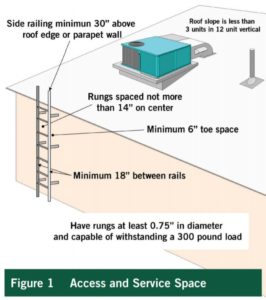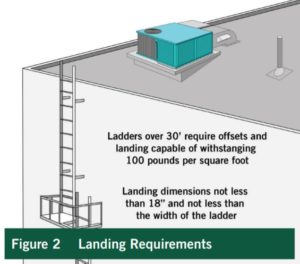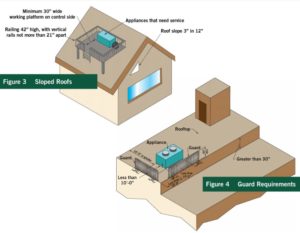
CodeNotes on worker safety on roofs
![]() One of the most dangerous jobs across the construction industry is performing work on rooftops. Falls are the leading cause of death in the construction industry, with the Occupational Safety and Health Administration (OSHA) citing that falls from roofs account for 34 percent of all fall deaths. To protect roofers from serious injury and death, it is important to identify hazards when working on rooftops and to follow critical safety steps to control these hazards. CodeNotes Worker Safety on Roofs and Elevated Structures, based on the 2015 International Mechanical Code (IMC), addresses the safety of occupants in buildings and provides for protection for service and inspection personnel.
One of the most dangerous jobs across the construction industry is performing work on rooftops. Falls are the leading cause of death in the construction industry, with the Occupational Safety and Health Administration (OSHA) citing that falls from roofs account for 34 percent of all fall deaths. To protect roofers from serious injury and death, it is important to identify hazards when working on rooftops and to follow critical safety steps to control these hazards. CodeNotes Worker Safety on Roofs and Elevated Structures, based on the 2015 International Mechanical Code (IMC), addresses the safety of occupants in buildings and provides for protection for service and inspection personnel.
Worker safety on roofs and elevated structures
 The 2015 IMC addresses the safety of occupants in buildings and provides for protection for service and inspection personnel. Where equipment requiring access and appliances are installed on roofs and elevated structures, safety for workers performing maintenance is a top concern. In IMC Section 306.5, the code requirement permits portable ladders for access to equipment located on a roof of buildings or on elevated structures when the vertical distance that must be climbed is not more than 16 feet above grade.
The 2015 IMC addresses the safety of occupants in buildings and provides for protection for service and inspection personnel. Where equipment requiring access and appliances are installed on roofs and elevated structures, safety for workers performing maintenance is a top concern. In IMC Section 306.5, the code requirement permits portable ladders for access to equipment located on a roof of buildings or on elevated structures when the vertical distance that must be climbed is not more than 16 feet above grade.
For climbs exceeding 16 feet in height, a permanent fixed ladder attached to the building or some other approved permanent means of access is required. The height of a parapet is always included in the measurement. Such access shall not require climbing over obstructions greater than 30 inches (762 mm) in height or walking on roofs having a slope greater than four units vertical in 12 units horizontal (33 percent slope). A permanent approved means of access, such as a fixed permanent ladder, is not required for Group R-3 occupancies.
Figure 1 illustrates the minimum design criteria required by Section 306.5. These specific dimensions were developed from OSHA requirements. In addition to width, rung and toe space dimension requirements, ladder side rails are required to extend above the parapet or roof surface at least 30 inches (762 mm) to provide a safe transition from the ladder to the roof for service personnel.
 As noted in Figure 2, fixed permanent ladders more than 30 feet (9144 mm) in height have additional requirements, including offset sections and landings with guards. The landings must be capable of withstanding a load of 100 pounds per square foot (488.2 kg/m2) and have minimum dimensions not less than 18 inches and the width of the ladder.
As noted in Figure 2, fixed permanent ladders more than 30 feet (9144 mm) in height have additional requirements, including offset sections and landings with guards. The landings must be capable of withstanding a load of 100 pounds per square foot (488.2 kg/m2) and have minimum dimensions not less than 18 inches and the width of the ladder.
Sloped roofs present a challenge for maintenance and service personnel in both traveling to an appliance and performing work at the appliance location. Section 306.5.1 of the IMC addresses this situation. Low slope roofs with a pitch of less than 3:12 (25-percent slope) are considered sufficiently flat to provide a safe walking and working surface. A roof with a slope of 25 percent slope to 33 percent slope is fairly easy to walk across without toe holds or safety devices, but these slopes require a level working surface at the appliance for safety of personnel and a means to prevent tools from sliding. The level work platform requires a 42 inch (1067 mm) high guard to prevent workers from stepping off the platform and possibly falling off the roof (see Figure 3).
Roof slopes greater than 33 percent are not considered to provide a reasonable level of safety for service personnel traveling to an appliance location, and another means of access is required in this case. On sloped roofs, where there is an obstruction greater than 30 inches (762 mm) in height in the path of travel to an appliance, fan or equipment requiring service, installation of a permanent ladder or a set of stairs in compliance with the International Building Code is required.
A receptacle outlet at or near the equipment location as required by Section 306.5.2 is more than a worker’s convenience requirement. The receptacle outlet not only accommodates power tools, drop lights and diagnostic equipment but negates the need for extension cords, which could be hazardous to service personnel.
Guards are to be provided where various components that require service and roof hatch openings are located within 10 feet (3048 mm) of a roof edge or open side of a walkway service and such edge or open side is located more than 30 inches (762 mm) above the floor, roof or grade below.
(See Section 304.11) The guard shall extend not less than 30 inches (762 mm) beyond each end of components that require service. The guard is to serve as a warning and as a protective barrier and must be not less than 42 inches (1067 mm) above the elevated surface adjacent to the guard. The guard rails must be constructed to resist the imposed loading conditions and must be constructed to prevent passage of a 21-inch (533 mm) sphere (see Figure 4).
There is an exception that allows anchorage-connectors devices to be installed at specific intervals and locations that allows service personnel to use safety harnesses and lines as part of a fall-arresting system in lieu of guards. This new exception is aimed at sloped roofs where such safety systems are typically utilized, but would apply to flat roofs as well, even though there would be no ridge and hip lines. Fall arrest/restraint anchorage connector devices shall comply with ANSI/ASSE Z 359.1 and must be affixed for use during the entire lifetime of the roof covering. The devices are required to be reevaluated for possible replacement when the entire roof covering is replaced.
As part of its goal to serve the needs of plumbing, mechanical and fuel gas (PMG) officials, the PMG Membership Council is committed to providing free, informative code support documents known as CodesNotes that can be used to complement building departments’ in-house weekly supplemental training. We hope you enjoy this newest edition of CodeNotes. Past topics include backflow devices and the protection of the water supply, gas pipe sizing based on the latest edition of the International Fuel Gas Code and the International Residential Code, and bonding of corrugated stainless steel tubing gas piping systems, just to name a few. The CodesNotes collection has recently been expanded to include a selection of notes offered in Spanish.
The PMG Membership Council website offers many resources. The council — open to all International Code Council members and serving the needs of PMG officials and industry professionals — consists of a great team of professionals who are willing to share their technical expertise and experiences. You’ll have the opportunity to discuss issues that you face as a community, and how the Code Council might best serve you. If you haven’t already done so, please go online and become a member of the PMG Membership Council.








